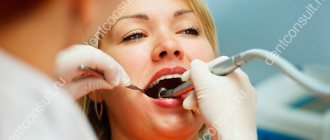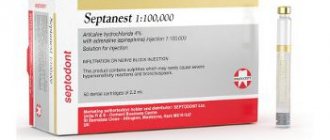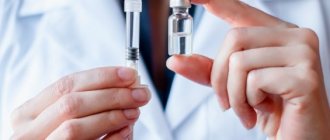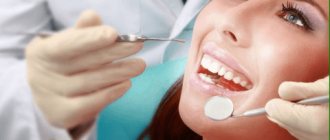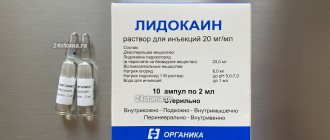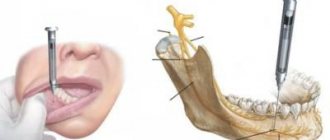04.11.2019
Anesthesia without adrenaline has been used in dentistry for quite a long time; it allows painless treatment even for those patients who have contraindications to common means of local anesthesia.
Typically, drugs that do not contain adrenaline are used in cases where it is necessary to treat teeth in patients with high blood pressure, heart disease, and pregnant or breastfeeding women.
What kind of drug is this - general information
We are talking about a high-quality anesthetic solution, which has been used in dental practice for quite some time. Manufactured by the French company Septodont. Until recently, the drug had exclusively analgesic properties and was produced without adrenaline, but later epinephrine (synthetic adrenaline) was added to its composition, a component of vasoconstrictor action. This made it possible to prolong the anesthetic effect and increase its reliability.
Thus, the composition includes two main active ingredients - articaine and epinephrine. The product is used for medical procedures of varying degrees of complexity, including simple surgical interventions and patch surgeries.
Release form and composition
The solution is available in 1.7 ml injection cartridges - they look similar to standard syringes, only the needles in them are many times thinner. This feature allows the injection to be performed with minimal discomfort for the patient. The drug is presented in two concentrations of the active substance: 1:100,000 and 1:200,000. The price, which varies from 1,500 to 2,000 rubles, also depends on this indicator.
The drug contains articaine and epinephrine
As mentioned above, Septanest contains articaine and epinephrine, as well as auxiliary components such as sodium hydrochloride, sodium bicarbonate and water. For comparison: articaine is 2 times more effective than lidocaine, and novocaine is 6 times more effective1.
Thanks to this composition, Septanest not only blocks pain receptors and neuromuscular transmission, but also affects blood supply. Epinephrine reduces the rate of penetration of articaine into the vascular bed, thereby providing a longer lasting analgesic effect. In this case, the drug is quickly excreted by the kidneys.
Indications for use
"Septanest" is used in dentistry for infiltration and conduction anesthesia during standard medical procedures and operations of varying complexity. Among the main indications for its use, experts highlight the following intervention options:
- removal of 1-2 or more teeth,
- treatment of caries and pulpitis (inflammation of the neurovascular bundle inside the tooth),
- depulpation – partial or complete removal of a nerve,
- bone surgeries, including removal of affected areas due to osteomyelitis,
- implantation,
- endodontic treatment – treatment and filling of root canals,
- operations on the mucous membrane, etc.
The solution is used for tooth extraction
“My doctor told me that Septanest is one of the best anesthetics, and I completely trust her. She explained that there is almost no bleeding with it, so it is very comfortable to work with. And of course the effect is stronger than other drugs. Personally, I never had any side effects, any procedure was painless. And they removed the nerve and treated the canals. I was terribly worried at first, but then after several procedures I completely calmed down. Now I’m not afraid to treat my teeth at all.”
Valeria Gapak, from correspondence on the forum www.32top.ru
The drug is widely used both in therapeutic treatment and in prosthetics and implantation. It has established itself as a high-quality, effective and proven product that guarantees complete painlessness and maximum comfort during the procedure.
General anesthesia in dentistry
Sedation is used for general anesthesia in dentistry. What it is? Sedation is a drug-induced sleep during which all reflexes are preserved, the patient can turn his head and open his mouth wider. If necessary, it can be quickly removed from this state. During sedation, a large number of teeth can be treated without discomfort. An anesthesiologist is constantly in the office; pulse, blood pressure, ECG, and blood oxygen saturation are monitored. After the operation, the patient feels only slight drowsiness and relaxation, there is no pain. This method is optimal in the presence of severe fear, hypertension, allergies to any type of anesthesia, and is suitable for children.
Instructions for use
According to the instructions, the solution is intended for injection into the area of pain relief, half or a whole cartridge, depending on the patient’s weight and the complexity of the upcoming procedure. The drug is not suitable for intravenous administration. Before opening the sealed package, wipe it with 96% alcohol. The cartridge must be disposed of after use.
For simple tooth extraction in the absence of an inflammatory process, 1.7 ml is injected under the mucous membrane. For additional pain relief, another 1-1.7 ml can be injected. To prepare carious cavities and grind crowns for single dentures, a vestibular injection of 0.5-1.7 ml is performed for each tooth (with the exception of lower molars). The maximum permissible dosage is 7 mg per 1 kg of weight.
How quickly does the effect occur and how long does it last?
The drug begins to act almost immediately – 1-3 minutes after administration. The duration of action largely depends on the individual characteristics of the patient’s body - on average 30-45 minutes. In order to prolong the effect, an additional dose of the solution can be administered. The maximum concentration is observed after approximately 17 minutes, the half-life is 25 minutes. The active substances are completely eliminated from the blood 3 hours after administration of the drug.
The effect begins almost immediately
What adverse reactions may there be?
"Septanest" is well tolerated by patients and usually does not cause adverse reactions. However, before using it, the doctor must take into account the current condition of the person and the presence of chronic pathologies in his anamnesis. In rare cases, an anesthetic with adrenaline may cause the following undesirable effects:
- excessive decrease in blood pressure with the risk of collapse and anaphylactic shock,
- headache, weakness and dizziness,
- disorders of the visual system, including double vision,
- nausea, vomiting, stomach pain,
- disturbances in the functioning of the cardiovascular system, including decreased heart rate,
- dermatitis, swelling and rhinitis as a result of individual intolerance to one or more components included in the composition,
- increased levels of sodium and magnesium in the blood.
The risk of side effects and the intensity of their manifestations depend on the amount of solution administered. If undesirable reactions occur, all necessary measures will be urgently taken to remove the active substances from the body and relieve acute symptoms.
Indications and features of use
Local anesthesia without adrenaline in dentistry is used in the following situations:
- If the patient has high blood pressure or cardiac dysfunction (heart disease, heart rhythm disturbances, failure, etc.). Moreover, for moderate hypertension, anesthetics with a reduced concentration of adrenaline are recommended; for severe hypertension, anesthetics with its complete absence are recommended.
- For dental treatment of children under 5 years of age.
- Women during pregnancy and lactation. Experts still recommend using drugs containing low concentrations of adrenaline so that the anesthetic is absorbed into the blood more slowly and does not penetrate the hematoplacental barrier.
- When treating patients with pathologies of the endocrine system, including those due to age (menopause in women) and those requiring thyroid hormone replacement therapy.
- Women during menstruation.
- Patients who are likely to develop adverse reactions: against the background of stress, while taking antidepressants or drugs that block beta-adrenergic receptors (some drugs to lower blood pressure and certain heart medications).
If the patient has one of these conditions or there is a suspicion that an adverse reaction to the anesthetic may develop, be sure to warn the dentist about this before starting treatment.
Is it possible to use Septanest during pregnancy?
The drug is not recommended for use during pregnancy. In 2013, clinical studies were conducted that proved the teratogenicity and fetotoxicity of the composition, which can be dangerous when used in the first and last trimesters. If there are no other options, Septanest should be used with extreme caution, as well as subject to mandatory follow-up monitoring of the condition of the patient and the fetus.
The drug should not be taken during pregnancy
The active ingredients of the anesthetic are able to penetrate not only through the placental barrier, but also into breast milk. Therefore, the drug is also not recommended for use during breastfeeding. If you still had to use the solution, after its administration you should refrain from feeding for 3 hours and express milk.
Contraindications for use
Like any other medication, this type of anesthesia has its contraindications. The main restrictions on its use are listed below:
- individual intolerance to components, tendency to allergic reactions,
- severe pathologies of the cardiovascular system, for example, malignant hypertension, heart failure, developmental defects and other serious conditions,
- epilepsy,
- acute and chronic renal and liver failure,
- diseases of the thyroid gland, such as myxedema and hypothyroidism.
Before using the drug, you should learn about contraindications.
As already mentioned, it is not used in pediatric dentistry for patients under the age of 4 years. Delay in the body of the active components of the drug is fraught with disturbances in its development.
Ubistezin
Ubistezin is a German drug that is produced. It contains the local anesthetic articaine and the hormone epinephrine (adrenaline), which has a vasoconstrictor effect. Vasoconstriction ensures a low degree of penetration of the drug into the blood and maximum effect at the site of use.
The drug has 2 release forms: with an epinephrine concentration of 1:200000 and 1:100000. The analgesic effect occurs within 1-3 minutes after administration. The duration of action is at least 75 minutes.
The drug is used only for anesthesia in dentistry (infiltration and conduction). It should not be administered intravenously or used in areas of inflammation.
Septanest
Septanest is an anesthetic that has been used in medical practice for quite some time. In addition to articaine and epinephrine, it contains auxiliary substances, which often cause complications of anesthesia in dentistry such as allergic reactions of patients. The drug is available in two dosage forms: with an epinephrine content of 1:100,000 and 1:200,000.
The effect of the drug appears after 1-3 minutes. Its duration is at least 45 minutes. It has good tissue tolerance and has a moderate vasoconstrictor effect.
Scandonest
What anesthesia in dentistry is suitable for patients with diabetes, thyroid diseases, an increased tendency to allergic reactions and patients with bronchial asthma? Scandonest is a drug that does not contain vasoconstrictor components or preservatives. Therefore, it is suitable for all patients at risk. For some, it is used with caution (during pregnancy, diseases of the liver, kidneys and cardiovascular system).
The anesthetic is produced on the basis of 3% mepivacaine. It provides fast, long-lasting and strong pain relief. Suitable for all types of local anesthesia.
Ultracaine
Ultracaine
– this is the best anesthesia in dentistry during pregnancy and for many diseases. It is based on articaine and is available in three forms: with a concentration of epinephrine 1:100000, 1:200000 and completely without epinephrine. The drug contains almost no preservatives. Lasts on average 2-3 hours. According to reviews from dentists and patients, ultracaine is the most potent among its analogues.
The cost of a carpule of any of the listed medications is approximately 30-50 rubles.
This article is for informational purposes only, please consult your doctor for details!
Drugs with similar effects
Septanest analogues are usually interchangeable because they have a similar composition. However, each has its own application characteristics, so the choice of the appropriate product remains up to the specialist. Among the popular anesthetics similar in action to Septanest, experts identify the following drugs:
- "Artifrin"
- "Artikain"
- "Artifrin"
- "Bupinecaine"
- "Ubistezin" etc.
"Ubistezin" is a high-quality modern anesthetic.
So, “Bupinecaine” is cheaper. It contains the same active ingredients, but in a different combination. This drug is also widely used for epidural and spinal anesthesia, that is, its scope is much wider. But “Artifrin” has a less pronounced anesthetic effect, therefore it is not used when working with inflamed soft tissues and in surgical practice.
Anesthesia without adrenaline in dentistry
Why is adrenaline needed in painkillers? It enhances the effect of the anesthetic by constricting blood vessels and capillaries, so that the anesthetic is concentrated at the injection site. In addition, adrenaline reduces bleeding, so drugs with adrenaline are optimal for operations with large blood losses. The most commonly used drugs with adrenaline are ultracaine, ubistezin and alfacaine.
Adrenaline anesthetic will not harm a healthy person. But if you have cardiovascular diseases (heart attack in the next six months), endocrine disorders (diabetes mellitus) or pregnancy, then adrenaline should not be used. Therefore, anesthetics such as lidocaine, pyromecaine, bupivacaine, trimecaine, prilocaine, and articaine are used. Non-adrenaline anesthetics begin to act more slowly than adrenaline ones, and their effect ends faster. At the same time, the safest anesthesia in dentistry is adrenaline-free.
Storage conditions
Septanest should be stored in a dry, dark place, at a temperature of no more than 25 °C. The solution should not be frozen, nor should it be left in direct sunlight or near heating sources.
Local anesthesia is a reliable and proven method that allows dental procedures of any complexity to be performed completely without pain and with maximum comfort for the patient. "Septanest" is one of the representatives of this category of drugs, the effectiveness and safety of which has been repeatedly proven clinically and in practice.
1Burda G.I. Experience in the use of ultracaine and septanest, 2000.
Electronic anesthesia in dentistry
This is a technique of anesthesia in dentistry in which the rate of administration of the anesthetic is under electronic hardware control. The anesthetic is delivered dropwise, without injury or stress, the needle moves smoothly. The advantages of using an anesthesia device in dentistry are the absence of pain, fast response (two minutes for pain relief), complete patient comfort (no discomfort before, after, or during the process), and accuracy of the injection.
Dental Guru clinics use an innovative method of computer anesthesia using the MEG-INJECT device, which allows you to accurately calculate the dose of the drug and the speed of its delivery. A thin needle ensures painless injection; application anesthesia is not required before the injection.
